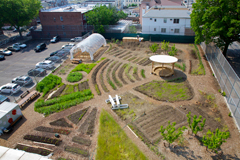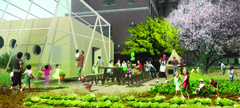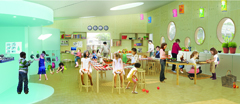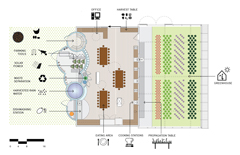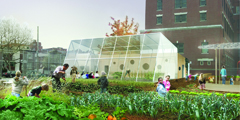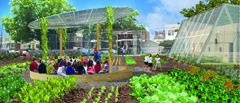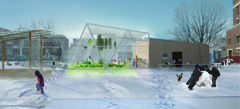Edible Schoolyard
Exhibit Category / Catégorie de l'expo: Community & Knowledge
Location/Emplacement: Brooklyn, New York, NY, USA
Dates: 1995 - present
Designers/Concepteurs: WORK Architecture Company
Clients: Public School 216 & Edible School Yard, NY
More Information/Plus d'informations: http://www.work.ac — http://esyny.org/
Image Credits/Crédits d'images: WORK Architecture Company
Project Description: (version française ci-dessous)
Schools offer a particular opportunity to initiate changes of attitude to the provision of food within an urban context. Several celebrity chefs have engaged in a debate about the quality of school meals and popular attitudes towards food. In contrast, the Edible Schoolyard program, initiated by renowned chef and author Alice Walters and the Chez Panisse Foundation in 1995, aims not only to improve school meals, but to educate school children in the skills of growing and preparing healthy food.
The Edible Schoolyard project began at the Martin Luther King Junior School in Berkeley, California, where a 0.4 ha organic garden and kitchen was created on an adjacent vacant lot. This acts as an interactive classroom used by teachers and specialist educators to integrate food systems into the core curriculum. The project has been successful in raising awareness about food issues in the Berkeley community where many other schools now have productive gardens, and was instrumental in the overhaul of the local school lunch program. The first Edible Schoolyard project in New York is being established in what was the parking lot at P.S. 216, the Arturo Toscanini School in Brooklyn.
“Edible Schoolyard NY”, as it is known, is designed by WORK Architecture Company, who have integrated urban agriculture elements into many of their projects. The challenge for the architects was to create an environment that can accommodate a comprehensive, interdisciplinary curriculum tied to the New York State Standard, connecting food to academic subjects taught at school. The architects have shown the potential of good design to create a unique learning environment centered on food by integrating a series of inter-related architectural elements, providing special teaching spaces, to complement a 1000 m2 organic productive garden to create learning, growing and cooking spaces that can function over the four seasons. The project is centered on a kitchen classroom that is surrounded by a mobile greenhouse on one side and a “systems wall” on the other, containing various service functions that ensure the building is self-sufficient.
This project engages school children, their parents and the community in the process of food production, but also demonstrates the principles of self-sufficiency. It engages them in discussions about how the food system impacts on their health, nutrition and the environment. The project illustrates the value of good quality design in bringing these concepts to a wider audience and shows the potential of urban food and agriculture to enrich the educational experience and the learning environment.
Browse for more projects in the Carrot City Index.
Description du Projet:
Les écoles offrent un environnement propice pour questionner l’accès à la nourriture en milieu urbain. Plusieurs grands cuisiniers ont participé à un débat sur la qualité des repas à l’école et sur le rapport que nous avons généralement à la nourriture. Le programme de cour d’école comestible a été lancé en 1995 par Alice Walters, grande cuisinière et auteure renommée, et la Fondation chez Panisse. Il ne vise pas seulement à améliorer les repas à la cantine, mais également à apprendre aux enfants à cultiver et préparer des aliments sains.
Le projet de cour d’école comestible a commencé à l’école primaire Martin Luther King à Berkeley, en Californie, avec la création d’une cuisine et d’un jardin potager biologique de 4000 m2 sur un terrain vacant adjacent. Les instituteurs et éducateurs spécialisés l’utilisent comme salle de classe interactive permettant d’intégrer les systèmes alimentaires au programme scolaire. La sensibilisation de la communauté de Berkeley aux thématiques de l’alimentation a permis de créer un jardin potager dans de nombreuses écoles. Le menu des repas de midi à l’école ont également été améliorés.
Le premier projet de ce type à New York est en cours de réalisation sur l’ancien parking de l’école Arturo Toscanini à Brooklyn. Il a été conçu par la Société d’architecture WORK qui intégre régulièrement des éléments d’agriculture urbaine à ses projets. Pour ces architectes, le défi consistait à créer un environnement pour un programme scolaire complet et interdisciplinaire, conforme aux directives de l’État de New York, qui associe l’alimentation aux matières enseignées à l’école. Les architectes ont mis en évidence le potentiel d’un bon travail de conception pour la création d’un environnement d’apprentissage unique axé sur l’alimentation : une série d’éléments architecturaux reliés entre eux offrent à la fois des espaces éducatifs particuliers associés à un jardin potager biologique de 1000 m2 et des espaces de culture et de cuisine opérationnels tout au long de l’année. Le projet s’articule autour d’une salle de classe-cuisine entourée d’une serre mobile d’un côté et, de l’autre, d’un « mur technique » comprenant différents modules qui assurent l’autosuffisance du bâtiment.
Ce projet implique aussi bien les élèves que leurs parents et les habitants du quartier dans le processus de production alimentaire et démontre les principes de l’autosuffisance. Des discussions invitent à une réflexion sur la façon dont les systèmes alimentaires influencent la santé, la nutrition et l’environnement. Le projet montre le rôle qu’une conception de bonne qualité peut jouer lorsqu’on entreprend de rendre ces concepts accessibles à un large public, mais aussi comment l’alimentation et l’agriculture urbaine peuvent enrichir l’expérience éducative et l’environnement de l’apprentissage.
Trouvez d’autres projets avec l’Index de Carrot City.


